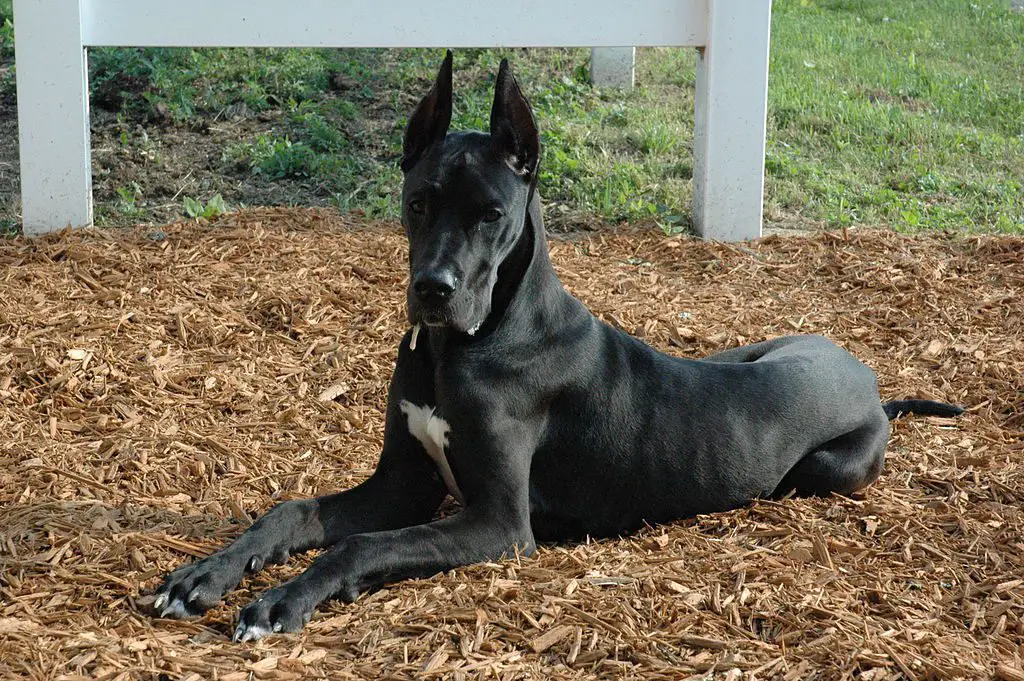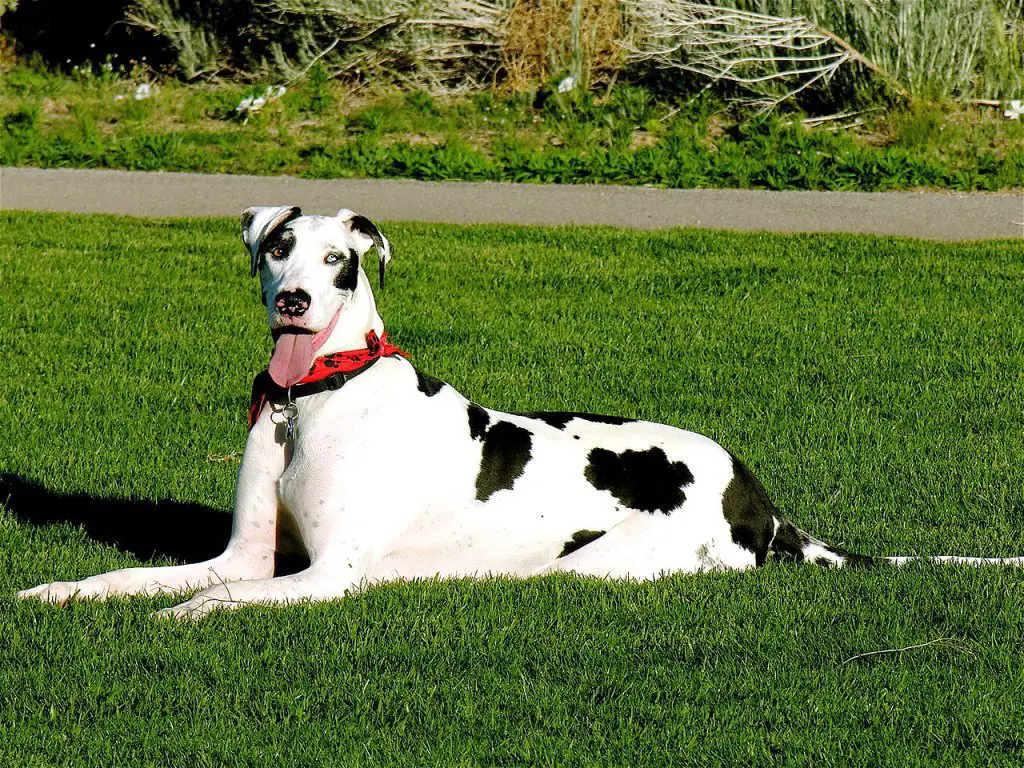Are you having trouble deciding on a color for your preferred Great Dane?
During your research, you’ve most likely come across many confusing labels that appear to describe the same color, or there appears to be an infinite number of Great Dane colors.
So, what color are most Great Danes? Continue reading to find out!
Key Takeaway
- Most Great Danes are commonly found in the color fawn, followed by black and black with white markings.
- Great Danes can sometimes become lighter in color as they transition from puppyhood to adulthood, although this change is usually temporary.
- Great Dane puppies can develop different colors as they transition to their adult coat, with the colors often becoming richer and darker.
What Color Are Most Great Danes?

What color are most Great Danes? Great Danes come in seven standard colors, however, most Great Danes are black. There are other pretty uncommon Dane colors. White Great Danes are the rarest because they are prone to many health issues. Great Dane dogs come in various coat colors and the coat color will depend on the parent’s DNA.
I prefer black-colored Danes because their skin coating is sleek, and they are adorable. There are numerous other color varieties, and you can select your preferred color for a Great Dane.
Note that a single Great Dane coat color can compete with the Great Dane’s majesty. However, according to Great Dane breed standards, not all Great Dane colors are recognized and preferred.
The Great Dane is a colossal dog whose bark is far worse than its bite. On the inside, this Gentle Giant is affectionate, loyal, and enjoys spending time with their family – often attempting to cuddle and be a lap dog!
Do Great Danes Ever Become Lighter In Color?

Yes. Instead of becoming darker all over, some Great Dane puppies may become lighter. While this is usually only a temporary change, owners are frequently surprised because they expect to see deeper coloration as time passes.
My puppy’s skin color has changed over time; at one point, it was quite dark, but it has since lightened. It should be noted that the lightening of the coat’s color is usually caused by one of two factors: shedding or sunlight.
Shedding
If a puppy sheds heavily, whether due to seasonal changes, blowing the puppy coat, stress, or health conditions, the coat will appear lighter in color for a short period. This apparent lightning is caused by the coat’s old, dead fur still clinging to it.
Young Great Danes will frequently transition to a much lighter color before the vibrant, new adult coat replaces the old one. Superior nutrition can significantly aid in the shedding process. Owners who switch to premium kibble usually notice a reduction in shedding.
Sunlight Exposure
Due to the bleaching effect of the sun’s rays, prolonged exposure can cause your puppy’s fur to lighten significantly in color. Of course, you shouldn’t expect a black dog to turn white, but deep, rich colors may dull, and light dogs, to begin with, may become paler.
There are seven standard Great Dane colors. Fawn is the best color to get in a Great Dane. Of course, color is simply that: a color. When selecting your new best friend, there are other characteristics to look for in a Great Dane.
Fawn is one of the most popular and widely used colors. When people see a fawn-colored Great Dane, they immediately recognize it. White is the unique color for a Great Dane. This is because the pup’s health is being harmed due to the color. The clown is the most expensive gentle giant. This is another well-known and easily identifiable color.
7 Standard Great Dane Colors
- Black Colored Great Dane: This is one of the most common Great Dane color.
- Black & White Great Dane: This coloration occurs when the Great Dane has a black coat with white markings.
- Blue Great Dane: The blue Great Dane has a tainted version of the black coat.
- Brindle Great Dane: To get a brindle Great Dane, cross a fawn-colored pup with another fawn or a fawn with a brindle. The base color is usually fawn or golden yellow, with black tiger-like stripes on top. A chevron pattern with a black mask is also possible. If both parents have the blue recessive gene, their child will have a blue brindle coat.
- Fawn Great Dane: Although fawn is the most popular and common color for a Great Dane, breeding one can be difficult. Because fawn is a recessive gene, both parents must have it if you want a fawn Great Dane puppy. This is one of the gentle giant’s simpler colors. Fawn is a golden yellow coat with a black mask marking. It may also have black on the rims of its eyes and the tip of its tail.
- Great Dane Harlequin: The harlequin Great Dane has a pure white base coat with black patches all over the body and is frequently misidentified as a Dalmatian. In dog shows, merle patches are also accepted. It isn’t easy to breed a harlequin because these genetics contain a lot of variabilities.
- Merle Great Dane: The Merle coat is similar to the harlequin coat, but the base color is grey rather than white. It has spots all over its body that can be black or white. Merle is the dominant gene linked to eye color, so it is important to avoid breeding two merles together.
What Are The Color Markings On a Great Dane?
Greates can have various color markings, including black patches, brindle patterns, and white markings on their chest, paws, and face.
- Markings in blue
- Blue mask
- Markings of bridle
- Chocolate splotches
- Chocolate mask
- Markings of fawn
- Merle patterning
- Piebald
It should be noted that there are mismarked Great Danes with mantle pups that are not the standard pure black with white and no other colors. Spotted Great Danes are usually white with black spots all over their bodies.
Do Great Dane Puppies Develop Different Colors?
Yes. Many Great Danes will slightly change as they mature into their adult coats. Most of the time, the colors will become richer, darker, and deeper, but color lightening is also possible due to shedding or exposure to a lot of sunlight.
My Great Dane puppy is currently a deep black color that I adore. This is after going through several stages of color change. Experts recommend that you wait until your dog has reached maturity before entering them in dog shows to ensure that their coat color is their true color.
When your puppy is about a year old, it will begin to shed its fluffy fur, replaced by a stiff, new coat. This will result in darker coat color. Unsuspecting owners are frequently taken aback when their dog’s coat color changes. Being aware of potential color changes in your growing puppy is best to avoid a shocking discovery later.
Do Great Dane Colors Affect Behavior?
The color of a Great Dane’s coat does not directly affect its behavior or temperament.
While there may be some color stereotypes or anecdotal observations, there is no scientific evidence to support the notion that certain colors make Great Danes more aggressive or have distinct personalities.
The temperament and behavior of a Great Dane are determined by a variety of factors such as genetics, socialization, training, and individual personality traits says Dr. Andrew Jones (DVM).
Therefore, it can be concluded that the color of a Great Dane’s coat does not have a significant impact on their behavior.
Do The Colors of Great Danes Affect Their Health?
Yes. Because it’s all in the genes, the color of your Great Dane may affect its health. While no dog is immune to health issues, you can have a healthy Great Dane if they don’t have a merle, white, or blue gene in them.
I don’t have any personal experience because none of my Great Danes’ skin colors have affected them. However, statistics show that white Danes are predisposed to various health problems due to their skin color.
Blue Great Danes may have skin issues due to their thin coat, but all Great Danes have short coats that cause skin irritation. If a Great Blue Dane has blue eyes, they have the Merle gene, which can cause problems.
Is it true that all white Great Danes are deaf? No. The dominant white gene causes an increase in deafness, but not every German Mastiff with this coloring is deaf. While Merles are lovely dogs, breeding them can result in stillborn or sick puppies, as well as blindness and deafness.
Your Great Dane puppies are also more likely to develop health problems later in life. These health issues are most common in White Great Danes, resulting from two Merles breeding.
What Color Great Dane Is The Most Expensive?
The most expensive color of Great Dane is the harlequin which can be priced up to $3,000 or more, depending on various factors such as lineage and pedigree.
The harlequin coat is characterized by a white base coat that is covered by black patches. This color is highly sought after and easily recognizable.
FAQs
Q: What is a harlequin Great Dane?
A: A harlequin Great Dane is a coat pattern characterized by a white base coat with irregular patches of black. This pattern is one of the recognized colors for the breed.
Q: What is a merle Great Dane?
A: A merle Great Dane has a coat pattern with patches of lighter color on a darker base coat. This pattern can create a marbled or mottled appearance in the coat.
Q: What is a brindle Great Dane?
A: A brindle Great Dane has a coat pattern with streaks or stripes of darker color on a lighter base coat. The pattern creates a unique and visually striking appearance.
Q: Can Great Danes have a blue coat?
A: Yes, some Great Danes can have a blue coat color. The blue coloration is a dilution of the black coat and is considered a recognized color for the breed.
Q: What is a mantle Great Dane?
A: A mantle Great Dane has a black base coat color with a white muzzle, neck, chest, belly, and legs. The white areas create a “mantle” appearance on the dog.
Q: What is a fawn Great Dane?
A: A fawn Great Dane has a light tan or golden coat color. This color can range from a pale cream to a deep golden hue.
Q: Can Great Danes have a white coat?
A: Yes, Great Danes can have a white base coat color. However, a pure white coat is less common and not recognized as an official color by breed standards.
Q: What is the rarest color for Great Danes?
A: The rarest color for Great Danes is generally considered to be the pure white coat. While not officially recognized, it is a popular and sought-after color among enthusiasts.
Q: Can Great Danes have a black and white coat?
A: Yes, Great Danes can have a black base coat with white markings. This coat pattern is known as black and white, and it can create a striking and elegant appearance.
Conclusion
As you can see, Great Danes come in a wide variety of colors and patterns! While you may have a preference for one color at first, the sweethearts of these wonderful creatures will undoubtedly win you over time, regardless of the color or pattern of their coats.
Hopefully, this post has been helpful and you won’t have a problem if I asked you (what color are most Great Danes?).




